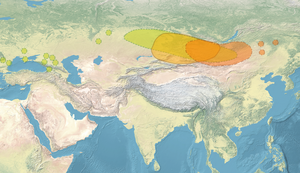
Back Pedres de cérvol Catalan Jelení kameny Czech Hjortesten Danish Hirschsteine German Piedras de ciervo Spanish Pierres à cerfs French אבן אייל HE Stele del Cervo Italian 鹿石 Japanese ირმის ქვა Georgian
General location of the Deer stones, and contemporary Asian polities c. 1000 BCE. : Type I, : Type II, : Type III, and scattered individual finds. The three types can be found together in the area of western Mongolia.[1] | |
| Geographical range | South Siberia, Western Mongolia |
|---|---|
| Period | Bronze Age, Early Iron Age |
| Dates | 1400 — 700 BCE[2] |
| Preceded by | Afanasievo Chemurchek culture Munkhkhairkhan culture Sagsai culture |
| Followed by | West: Arzhan, Chandman, Pazyryk culture East: Slab-grave culture |

Deer stones (Mongolian: Буган чулуун хөшөө, Chinese: 鹿石; pinyin: lùshí), sometimes called the Deer stone-khirigsuur complex (DSKC) in reference to neighbouring khirigsuur tombs,[3] are ancient megaliths carved with symbols found mainly in Mongolia and, to a lesser extent, in the adjacent areas in Siberia: 1300 of 1500 the deer stones found so far are located in Mongolia. The name comes from their carved depictions of flying deer. The "Deer stones culture" relates to the lives and technologies of the late Bronze Age peoples associated with the deer stones complexes, as informed by archaeological finds, genetics and the content of deer stones art.[4]
The deer stones are part of a pastoral tradition of stone burial mounds and monumental constructions that appeared in Mongolia and neighbouring regions during the Bronze Age (ca. 3000–700 BCE). Various cultures occupied the area during this period and contributed to monumental stone constructions, starting with the Afanasievo culture, and continuing with the Okunev, Chemurchek, Munkhkhairkhan or Ulaanzuukh traditions.[5][6] The deer stones themselves belong to one of the latest traditions of monumental stones, from circa 1400 to 700 BCE (Late Bronze Age to Early Iron Age), but precede the Slab grave culture.[2] The deer stones also immediately precede, and are often connected to, the early stages of the Saka culture (particularly the Arzhan, Chandman and Pazyryk cultures) in the area from the Altai to Western Mongolia.[7] Deer stone art is earlier than the earliest Scythian sites such as Arzhan by 300 to 500 years, and is considered as pre- or possibly proto-Scythian.[8]
The Deer stones culture seems to have been influenced by the contemporary Karasuk culture to the northwest, with which it shares characteristics, particularly in the area of weapon metallurgy.[9][10]
- ^ Fitzhugh, William W. (1 March 2017). "Mongolian Deer Stones, European Menhirs, and Canadian Arctic Inuksuit: Collective Memory and the Function of Northern Monument Traditions". Journal of Archaeological Method and Theory. 24 (1): Fig. 18. doi:10.1007/s10816-017-9328-0. ISSN 1573-7764. S2CID 254605923.
- ^ a b Fitzhugh 2009.
- ^ Fitzhugh 2009a, p. 183.
- ^ Fitzhugh 2009b, p. 73, "Because deer stone art illustrates many features of the lives and technology of these late Bronze Age peoples...".
- ^ Baumer, Christoph (18 April 2018). History of Central Asia, The: 4-volume set. Bloomsbury Publishing. p. 157. ISBN 978-1-83860-868-2.
- ^ Taylor, William; Wilkin, Shevan; Wright, Joshua; Dee, Michael; Erdene, Myagmar; Clark, Julia; Tuvshinjargal, Tumurbaatar; Bayarsaikhan, Jamsranjav; Fitzhugh, William; Boivin, Nicole (6 November 2019). "Radiocarbon dating and cultural dynamics across Mongolia's early pastoral transition". PLOS ONE. 14 (11): e0224241. Bibcode:2019PLoSO..1424241T. doi:10.1371/journal.pone.0224241. ISSN 1932-6203. PMC 6834239. PMID 31693700.
One rare source of empirically dateable material useful for understanding eastern Eurasia's pastoral tradition comes from the stone burial mounds and monumental constructions that began to appear across the landscape of Mongolia and adjacent regions during the Bronze Age (ca. 3000–700 BCE). Here, along with presenting 28 new radiocarbon dates from Mongolia's earliest pastoral monumental burials, we synthesise, critically analyse, and model existing dates to present the first precision Bayesian radiocarbon model for the emergence and geographic spread of Bronze Age monument and burial forms. Model results demonstrate a cultural succession between ambiguously dated Afanasievo, Chemurchek, and Munkhkhairkhan traditions. Geographic patterning reveals the existence of important cultural frontiers during the second millennium BCE.
- ^ Jacobson-Tepfer 2023, pp. 158–159, "Within the Altai region, despite one major, surviving coincidence of deer stones and khirgisuur (Tsagaan Asga), burial mounds of the early Scythian Pazyryk culture are the only monument type with which deer stones are regurlarly associated..
- ^ "The Mysterious Steles of Mongolia". CNRS News.
Nearly a thousand ornamented steles dot the Mongolian steppes. These "deer stones" were erected between 1200 and 800 BC, and are part of large funerary complexes built by nomads from the Karasuk culture or Deer stone civilisation.
- ^ Turbat, Tsagaan; J.Gantulga; N.Bayarkhuu; D.Batsukh; N.Turbayar; N.Erdene-Ochir; N.Batbold; Ts.Tselkhagarav (2021). Tsagaan Turbat (ed.). "Deer Stone Culture of Mongolia and Neighboring Regions". Institute of Archaeology, Mas & Institute for Mongol Studies, Num. Ulaanbaatar.
Weapons depicted on the Deer stones commonly found from the Mongolia and neighboring regions such as Southern Siberian Karasuk culture (13-8th centuries BCE) as well as Northern Chinese and Early Scythian graves (7th century BCE). (...) Based on relative chronology, MT type Deer stones belongs to the Karasuk period (13-8th centuries BCE) or according to new Siberian archaeology terminology (Polyakov 2019): to the Late Bronze Age period. A well-known example is that some emblematic objects of the Late Karasuk period were depicted on Deer stones. Moreover, the absolute dating of Deer stones and the Khirgisuur, the chronologically identical and directly related funeral-ritual structure to the former, were dated to the 13-8th centuries BCE as well.
© MMXXIII Rich X Search. We shall prevail. All rights reserved. Rich X Search

